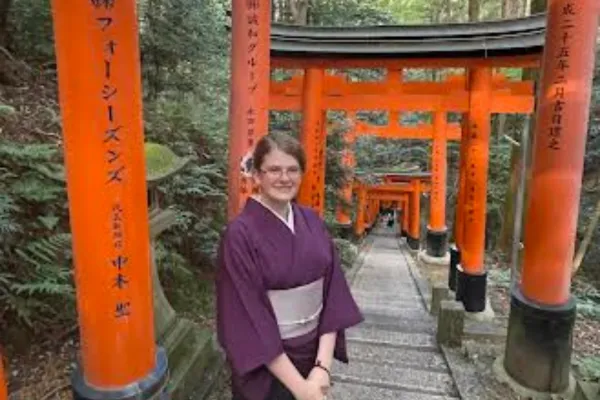
My Trip to the Fushimi Inari Shrine
Hello Adventures,
One of the Highlight of my Trip to Japan was my day at Fushimi Inari. This day was my second last day staying in Kyoto and my group and I spent our morning exploring the Fushimi Inari Shrine.

Fushimi Inari
Fushimi Inari Shrine is a famous for its thousands of red Torii Gates leading the whole way up the mountain. This shrine, located in south Kyoto, is the largest Shinto shrine in Japan dedicated to Inari, the god of rice, tea, sake and prosperity. With how important these elements are to Japanese culture it is unsurprising that about a third of Japanese Shinto shrines are dedicated to Inari.
Inari is commonly known for their connection to Kitsune and Foxes as foxes. Kitsune are a Japanese fox yokai and the messengers for Inari, delivering news and advice to humans. Foxes are furthermore connected to the harvest god due to their hunting of agricultural pests such as mice.
To represent these Kitsune or messenger foxes sets of white or stone fox statues, commonly representing a female and male duo, guard the shrines. These statues hold keys, scrolls and jewels in their both to represent significant items to Inari. These statues often also have bibs and head coverings to show appreciation to Inari for his protection.

Getting Ready
We arrived around 10am to the trains station and it was crazy busy with large lines to get out the single exit. Luckily the shrine is right near the station.
My group planned an hour to spend at the shrine before heading to the Arashiyama Bamboo Forests, but I had different plans. Having bought a Kimono the day before, my goal was to make it to the summit of the Mountain trail wearing my Kimono. Since I couldn't figure out how to tie my Obe, the waist band, I decided I would go to a Kimono rental place where they supply the undergarments, shoes, accessories and do your hair.
Getting ready took most of the hour so I met up with the rest of my group before they left for the bamboo forests, and I had yet to enter the temple.

At the shrine and along the trail I collected 3 Goshuin. Goshuin means 'honourable red seal' and it is a type of red stamp with calligraphy over it. These are unique to certain temples and are a paid stamp that can only go into special Goshuin books or onto Goshuin paper. They signify that you have visited the shrine. There were 3 to be found at Fushimi Inari, one at the main temple and 2 along the trail.


The trip to the summit and back down is anticipated to take 2-3 hours following the established looping path.
I started my day at the shrine exploring the primary shine at the base of the mountain and went to a small cafe off to the side to get tea and a snack. Here I tried matcha ice cream for the first time. to me it was okay but tasted like sweetened grass with an odd tang.
The first stretch is a smaller loop turning left through a tunnel of Torii gates before you get to the primary loop. Here I cannot remember which way I went but it was very well lit and had a few stopping spots and a large lookout.
The way down was darker and damper but still very nice and quiet.

This adventure was one of the highlights of my 2024 Japan trip and I hope to visit Japan again soon.
